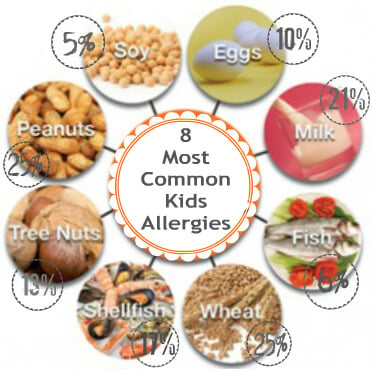According to the US Centers for Disease Control and Prevention, about 4 percent of children under 18 have some kind of food or digestive allergy. That number represents an increase of 18 percent for all food allergies among children between 1997 and 2007.
For some foods, the increase has been even greater. For example, peanut allergy prevalence has quadrupled from 0.4 percent in 1997 to more than 2 percent in 2010. In fact, peanut allergy is now the leading cause of anaphylactic shock — the most severe form of allergy — due to food in the United States. And the problem isn’t just confined to the US: hospital admissions for food-related anaphylaxis has seen a seven-fold rise in the United Kingdom since 1990.
So, what’s going on? Assuming these increases are bona fide, what’s causing them?
There is no short list of culprits. Microbiome, Western diet, and socioeconomic status to name a few. A number of groups have also blamed genetically modified food. According to the Organic Consumers Association, the main trade group for the organic food industry:
Genetic engineering, for instance, can increase existing allergens, or produce new, unknown allergens. Both appear to have happened in genetically modified (GM) soy, which is found in the majority of processed foods.
Jeffrey Smith, head of the Institute for Responsible Technology, author of the books Seeds of Deception and Genetic Roulette, weighed in with this advice:
Beginning in 1996, genes from bacteria and viruses have been forced into the DNA of soy, corn, cotton, and canola plants, which are used for food. Ohio allergist John Boyles is one of a growing number of experts who believe that these genetically modified (GM) foods are contributing to the huge jump in food allergies in the US, especially among children.
 However, of the foods that most frequently cause food allergy, GM versions simply don’t exist.
However, of the foods that most frequently cause food allergy, GM versions simply don’t exist.
There is no GM peanut (although development of a hypoallergenic GM peanut is ongoing). There is no GM milk. Or consumable GM egg (although there is now that makes medicine). However, a few cases of allergenicity cropped up during early experiments involving genetically engineered foods, which piqued concerns.
- The first, in 1996, involved the transfer of a Brazil nut protein into a soybean to enhance the soy’s nutrition. However, the allergenic properties of the Brazil nut protein 2S albumin, a common allergen, also were transferred over and triggered an allergic reaction in experimental human volunteers. The 2S albumin was transferred because of its methionine (an essential amino acid) content. The experiment was halted.
- The second involved an Australian experiment in 2005 on mice in which a bean protein designed to resist the pea weevil (an insect pest) ended up triggering severe immune reactions in the mice. While the alpha-amylase inhibitor protein itself was expressed in mice, it had changed glycosylation (sugars that coat the protein). Glycosylation is a very specific, and changes in these sugar coatings can trigger an immune response against the “new” protein. Not only was this found out quickly through a thorough study, today’s immunological products have more ways to significantly reduce these changes in glycosylation.
Both of these incidents show one of three ways an allergy risk could possibly increase from GM foods. The incidents involve transferring a known allergen (either a Brazil nut protein, or glycosylation) into a food crop. A second way is to increase the inherent ability of a GM crop to cause allergies. However, no studies have found heightened intrinsic allergenicity when compared with non-biotech equivalents. The third way involves the creation of a brand new, novel protein that could trigger an allergy. Though this last possibility, of a “franken-protein,” has caught media attention and been used by anti-GMO groups, it has not yet happened.
European Union health agencies, and member nation health agencies, as well as the US FDA, EPA and USDA, are all involved in necessary rigorous assessments of GM foods (or any other foods) for allergic potential. The EPA, in fact, maintains an extensive list of foods that could trigger allergies. Another resource used to test for allergens is the University of Nebraska’s Allergen Online, which matches amino acid sequences of possible allergens with reference proteins known to cause allergies. And, so far, no single biotechnology-based protein in food has been found to cause an allergic reaction.
While any food could cause an allergic reaction in somebody, some patterns have arisen:
- First, allergens are nearly all proteins. Thus, by studying the amino acid sequence of a potential genetically engineered protein and comparing to amino acid sequences of known allergens, it is relatively straightforward task to determine early on if a protein might cause problems.
- Nearly all allergens trigger a complex immune system process that results in the creation of antibody called IgE (immunoglobulin type E). An allergy is triggered by the second exposure to the allergen, by triggering a reaction from IgE. However, the specific proteins that trigger this reaction vary a great deal.
- While food allergies can come from any food, the overwhelming majority (90 percent) come from eight foods: Peanuts, wheat, soy, milk, shellfish, fish, eggs and tree nuts (Brazil nuts, walnuts, almonds). In children, most allergies are caused by eggs, milk, and peanuts.
- Allergies are not the same as intolerances, such as lactose intolerance. Intolerances are caused by different molecular and biological mechanisms, such as the absence of an enzyme (like lactase), and don’t necessarily require the complete avoidance that allergies do. They are not the same as toxins, which create an immediate reaction on first exposure.
If not GMOs, then what?
The causes behind the increase in food allergies are not known. While anti-GMO groups have pointed to biotechnology, there are other proposed causes, each with a varying degree of data to support each:
- The “hygiene hypothesis,” which proposes that a more germ-free existence during infancy and early childhood doesn’t trigger immune reactions to pathogens at an early age. This means, the hypothesis goes, that such immune systems don’t recognize true pathogens and reacts instead to what should be harmless stimuli (i.e., food).
- Birth by caesarean section, because a baby born this way does not acquire its mother’s gastrointestinal bacteria that it would during a vaginal birth. This development of the infant’s microbiome could help boost immunity to pathogens, but without proper (or any) development, allergies may result. Babies born by caesarean section do appear to have a higher risk of developing food allergies.
- Food additives, like sulfites and sodium benzoate, may trigger reactions in some people. Artificial sweeteners and food colorings may also cause allergies in sensitive people. These additives are common parts of nearly all foods, and while some are added during processing, others are natural.
- Genetics and inheritability aren’t very clearly linked to food allergies, especially when viewing them in general. A Johns Hopkins study found a 20 percent penetrance (the degree to which a version of a gene causes the predicted phenotype) of genes around two significant immune genes, HLA-DR and HLA-DQ, associated with peanut allergy, but they also found that not everybody with these genes gets an allergic reaction.
The typical treatment for food allergy is avoidance. However, some studies have shown some there may be a better treatment, as well as insights into the etiology of allergies.
- A British study on peanuts carefully measured allergic reaction in 500 infants when the children reached five years of age. All the infants were at high-risk of peanut allergy, and when they were five, given an oral challenge (basically, given a peanut and then measured for a reaction). 17.2 percent of children who had avoided peanuts since infancy had an allergic reaction, while just 3.2 percent of the children who had consumed peanuts since infancy had an allergic reaction. In addition, among children who had no apparent risk of allergy, 13.7 percent of children who avoided peanuts did have an allergy, while just 1.9 percent of children who ate peanuts had such an allergy.
- A large Australian survey of more than 5,000 infants found that risks of allergy included parents born overseas (especially from Asia), delayed consumption of eggs, peanuts and sesame, and family history. Dogs, however, were apparently protective from allergic risks.
- A University of Chicago team fed Clostridium bacteria (the same genus, but not the same species as C. difficile, the scourge of hospital-acquired infections worldwide) to mice that had been raised in sterile environments. With no microbiome developed in their intestinal systems, the mice developed severe allergic reactions to peanuts. Clostridium, however, fought off the allergic reaction.
Allergic reactions are complex. Even though eight foods cause most allergies, many more can cause specific reactions, because everybody’s intestinal, nervous and immune systems are different (not to mention their genetics). While certain genetically engineered experimental foods were found to have allergens, these allergens were known and caught by researchers in early stages, just as a test on organic peanuts would also show a potential allergic reaction in sensitive people. And further studies have shown that transgenics technology does not make a food any more allergenic — but neither does it automatically make it less (unless the target trait is allergenicity).
A version of this article originally ran on the GLP on September 13, 2107.
Andrew Porterfield is a writer and editor, and has worked with numerous academic institutions, companies and non-profits in the life sciences. BIO. Follow him on Twitter @AMPorterfield































